RECOIL OFFGRID Preparation Naked and Afraid: The Naked Truth
In This Article
Compared to most animals, humans are extremely fragile. We don’t have sharp claws and teeth for hunting, and we lack the powerful sense of smell and ultra-precise eyesight other apex predators are equipped with. Most importantly, when you strip away the insulated fabrics and durable footwear we’ve spent thousands of years developing, we can’t rely on tough hide or warm fur.
Our exposed bodies are virtually defenseless against environmental factors such as wind, rain, cuts and scratches, and insect pests.
Even the most experienced survivalists shudder at the thought of being stranded in the wilderness with no clothing and minimal tools. This concept led to the development of Discovery’s survival TV series Naked and Afraid, which has aired 15 seasons over the last 10 years. On the show, each contestant is paired up with a stranger and dropped off in a challenging environment for 21 days (or 40 for the spinoff Naked and Afraid XL).
Locations have included every continent except Antarctica, ranging from swamps to grasslands and from deserts to rainforests. Although a camera crew is present during the day, they’re not allowed to intervene unless there’s a medical emergency; at night, the contestants must film themselves using a provided camera.
In order to learn more about the actual reality behind this “reality TV” survival series, we spoke with three former contestants: Zach Benton, Hakim Isler, and Melissa Miller. Read on as they discuss their experiences, struggles, and lessons learned from Naked and Afraid.
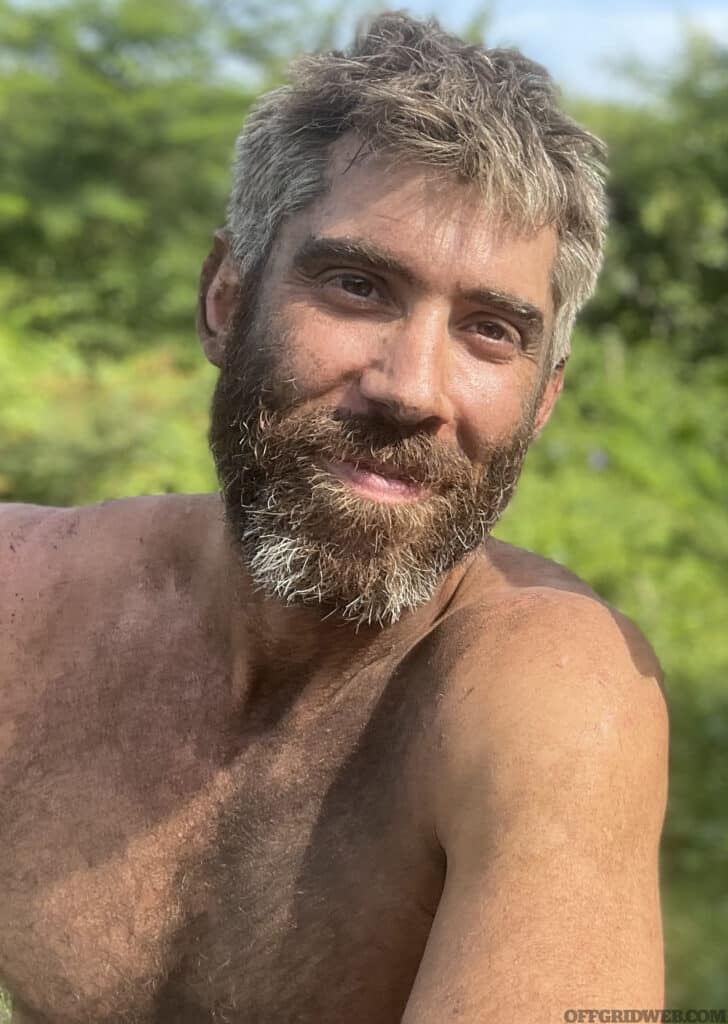
Above: Zach during his Naked and Afraid challenge in Colombia.
Age: 38
Hometown: Jarrell, Texas
What season(s) did you participate in? Where did you go?
I was on Season 14, Episode 2, “Haunted and Hungry.” It took place in Cartagena, Colombia.
Tell us a little about your survival skills background going into the show.
I grew up on a 3,300-acre cattle ranch playing mountain man and Boy Scout as a kid. I learned a lot about fieldcraft and autonomy in nature as a Scout Sniper in the Marine Corps. Wilderness survival became a favorite topic of study as an adult chasing adventure, and when the opportunity to do the NAA challenge came up, I read 18 books in three months to prepare.
We understand each contestant was allowed to bring one item. What did you bring, and why?
For this season, each contestant was required to bring four items. We handed them over when we arrived in Colombia, and the producers picked what my partner and I would get for our challenge. I took a tarp, knife, pot, and ferrocerium fire-starter. What they ended up giving us was a mosquito net, pot, knife, and fire-starter.
Exposure is a serious threat in any outdoor setting, and nudity is the ultimate form of exposure. What challenges did being naked pose?
The primary issue with being naked in the jungle is the bugs. I was there in August, and the temperatures were only low during the big rainstorms, so maintaining core temperature wasn’t too difficult. The other big problem was my feet. The jungle is blanketed in a layer of thorns, and my feet were swollen, sore, and filled with edema.
One of the books I read leading up to the trip was Native American basket weaving, so on day eight I wove a pair of shoes out of grass and tree bark. To be able to walk normally lifted a huge weight off the mental aspect of the challenge.
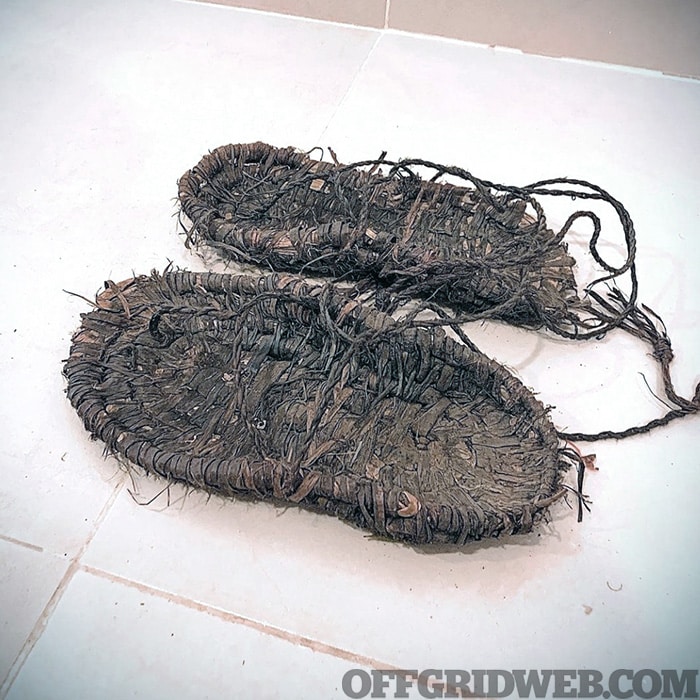
Above: Prior to the challenge, Zach read more than a dozen books on survival skills, including one about Native American basket weaving. He used the knowledge to weave this pair of sandals from grass and bark.
It’s in the name, so we’ve got to ask. Were you afraid out there? Tell us about the psychological impact of the scenario you faced and how you dealt with it.
I never felt like I was in any direct danger. I could hear the caiman in the swamp and the howler monkeys swung through the treetops around my camp, screaming every morning and evening, but I never felt afraid. Being alone at night in the jungle, naked, with nothing but a knife certainly presented all the reasons I needed if I wanted to freak out, but I managed to control my thoughts enough to not let it consume me.
The psychological difficulty for me was my personal life. I had just got home from Kabul a month prior. Before I left again for Colombia, my 3-year-old crawled into my lap and thanked me for coming to visit him. I’d been deploying overseas back and forth all his life, so he didn’t understand that I lived there. It was a heavy thought to carry into the jungle and sit with for 21 days, 17 of them solo.
What were your survival priorities going into the show? How did they change once you were out in the field?
Priorities going in were fire, water, shelter, food, security. The order didn’t really change but it took me way longer than I expected to resolve fire, water, and shelter. Food and security took a backseat, which is why I lost 30 pounds. The jungle was filled with wood-eating ants and so every dead stick I found — whether off the ground or in the trees — was completely eaten from within.
I could burn it, but it gave me no coals, just ash, and only lasted 20 minutes. This dilemma kept me shackled to camp for the majority of the first 10 days because without fire I couldn’t sterilize the water and without water, well…
With every reality TV show, we always wonder if events are scripted or if producers intervene to make the show more exciting. Did you experience anything like that?
No, it’s definitely not scripted, not for me anyway. The only things a viewer that has an eye for production might notice are shots on the insertion or extraction because they will request your cooperation on the hike so they can get cool-looking footage.
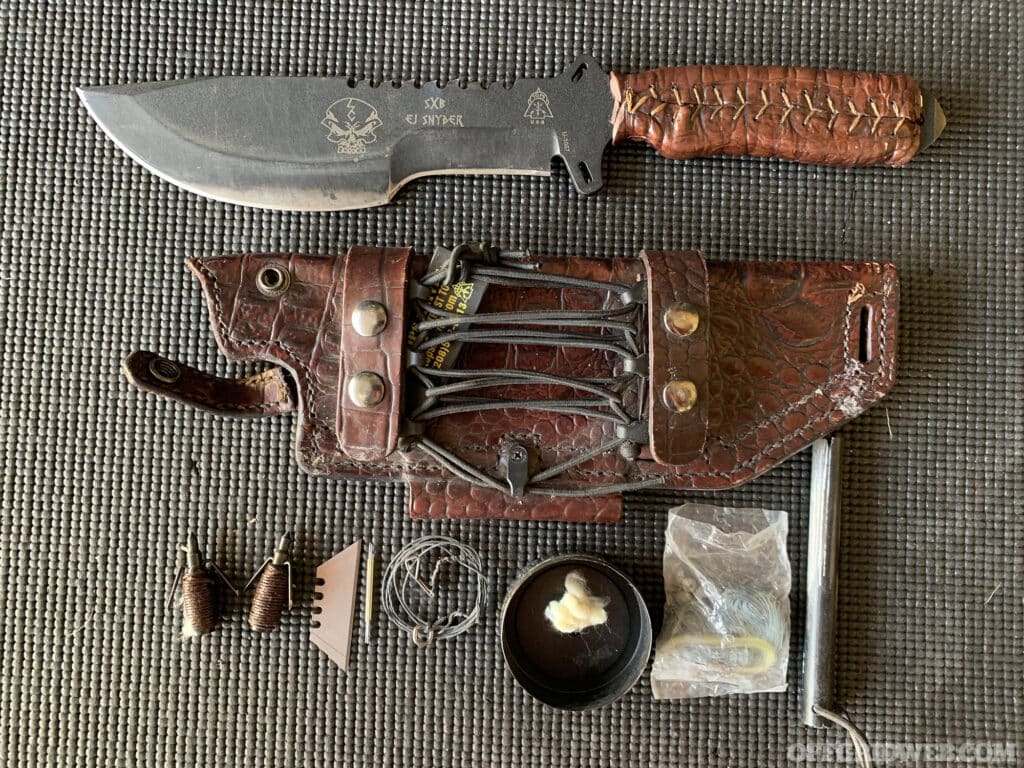
Above: Zach’s knife of choice is a customized TOPS Knives SXB fixed blade originally designed by fellow Naked and Afraid contestant EJ Snyder, who we interviewed in RECOIL OFFGRID Issue 24.
What was it like attempting to survive alongside a partner you had never met before?
My partner was very nice, but she didn’t stay very long. We worked together pretty well but she got sick on day two and left at sunrise on day four. The remaining 17 days I completed alone. I’m grateful for that experience. I would have spent the rest of my life wanting to know if I could do it alone, but it would have been much more enjoyable to have had someone to share it with.
How did your time on the show end, and what survival lessons did you walk away with?
My last few days were a transition from grinding each day to maximize productivity to managing the bare necessities in an effort to not get hurt. The lack of food and muscular atrophy had me stumbling around, and my knife flew out of my hand a number of times chopping wood. It became an issue of risk mitigation to make sure I made it to 21 days without something stupid happening at the end.
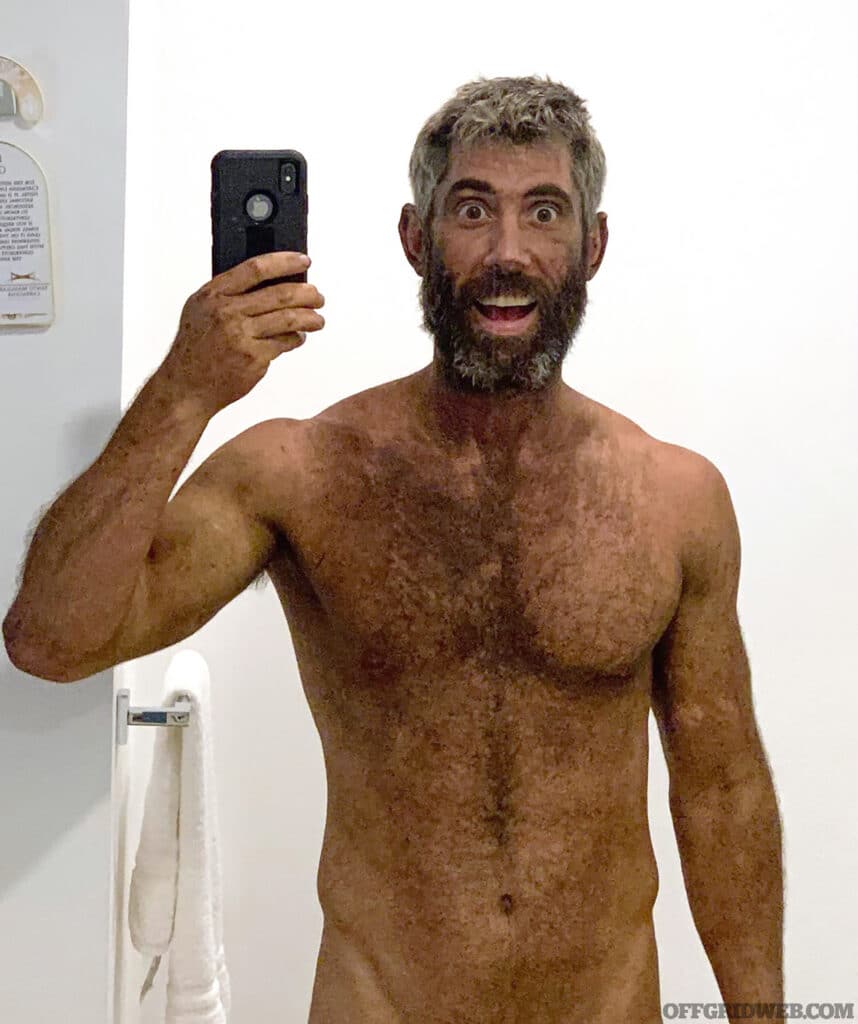
Above: After 21 days naked in the jungle, Zach was caked in dirt from head to toe and had lost 30 pounds.
Please tell us about your latest projects and where we can follow you online.
My latest projects include the FTW Ranch Podcast. I’m a precision rifle and hunting instructor at the FTW Ranch, a 12,000-acre fortress in Barksdale, Texas, with 36 shooting ranges scattered through deep canyons in the hill country, jungle/safari hunting courses with charging buffalo, elephants, plains game, and a maximum of two miles of range.
We host everything from Tier 1 sniper training to some new hunter classes with exotic game to hunt and a professional chef to teach the preparation.
I have another podcast hosting opportunity for Zero Foxtrot in the works to tell amazing stories of moments that required full commitment, where zero f*cks could be given, in the face of triumph or defeat.
Lastly, in December, I partnered with a director who has rewritten a book of mine into a movie. Oddly, I never finished writing the book, but it has been an adventure to be a part of that process and an honor to have a team of people helping me make it happen.
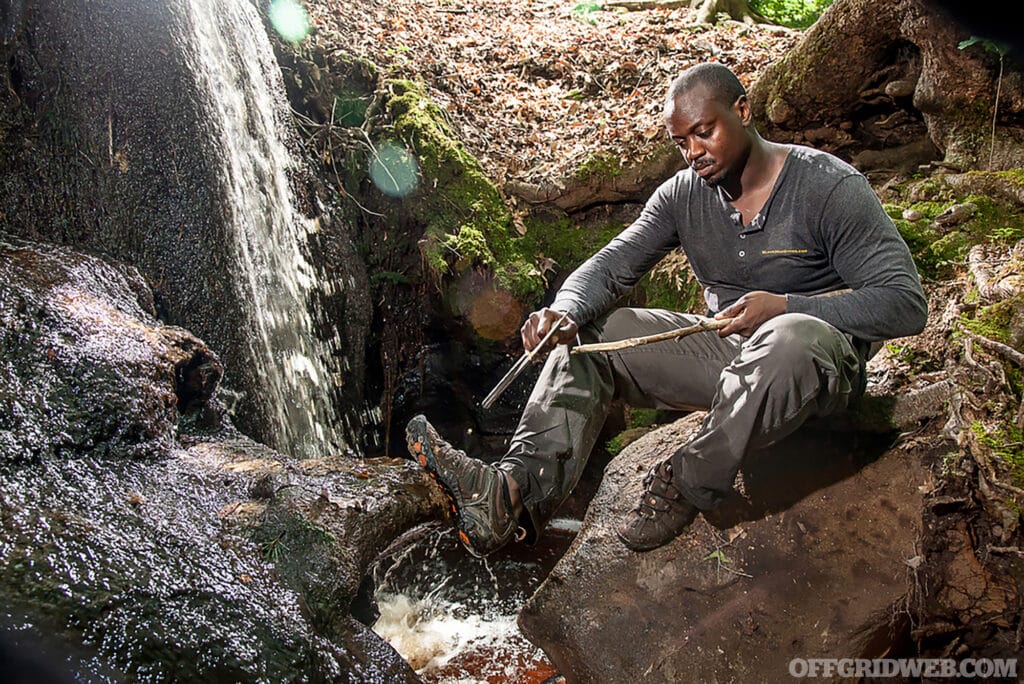
Above: Once he headed into the wilderness, Hakim says his priorities quickly diverged from his expectations. Adaptability became an important part of his survival skillset.
Age: 46
Hometown: I grew up in Newark, New Jersey. I currently live in Fayetteville, North Carolina, just outside Fort Bragg (now Fort Liberty).
What season(s) did you participate in? Where did you go?
I participated in two seasons of Naked and Afraid. I went to the Himalayan Mountains in India on Season 3, and then I was on the first 40-day challenge in the Colombian jungle.
Tell us a little about your survival skills background going into the show.
I didn’t have any real background growing up in New Jersey — I come from the concrete jungle, not the real jungle [laughs]. When I moved to Ohio, I moved specifically to train in ninja martial arts under Stephen K. Hayes, who brought ninjutsu to America. While I was there, we did outdoor and wilderness experiential training based on our lineage. That was where I got my first taste of outdoor training.
Then, I joined the Army and began with land navigation and things of that nature. I went to SERE school and learned more about wilderness survival from a tactical perspective, as well as just survival in general. When I got out of the military, a friend of mine had a survival school, and I worked there for a little while, helping out and learning from them. Then, the Naked and Afraid opportunity came up, and I jumped into that.
We understand each contestant was allowed to bring one item. What did you bring, and why?
That’s a very interesting question. I had designed an ax called the Tengu. The tengu is a mythological, benevolent creature — like half man, half crow — that was believed to live in the wilderness of Japan. Some legends have it that they taught the ninjas in these villages skills related to how to use nature to their advantage. I thought it was fitting to name this ax the Tengu, since it was going to be with me on this journey of becoming one with nature.
The Tengu ax had multiple surfaces and features added to it — a skinning knife on top, a notch-maker, a cutting surface, and a hooking surface to pick up logs and look under them without putting your hand under them. That was probably the greatest choice I’ve made, because we cut, skinned, chopped, scraped, everything with it. I wanted something versatile, so that’s why I designed it.
Exposure is a serious threat in any outdoor setting, and nudity is the ultimate form of exposure. What challenges did being naked pose?
They were extremely significant. According to the “law of threes,” you can only handle three hours of extreme exposure before you’re either dead or dying. So, being in an environment like the Himalayas that was in the 30s at night and 60s during the day, that was very intense. It created challenges like not wanting to move, because even a small breeze would result in shivering.
Then, there was the fact that we didn’t have shoes on, so constant walking around and getting stabbed on the bottom of our feet over long periods of time was overwhelming. It also forced us to move slowly. Having bugs land all over us and on our private areas and not being able to do anything about it was also very difficult.
People say all the time, “Well, why didn’t you make clothes?” Because the environment was so harsh, making clothes was the low thing on the totem pole. Just to make it through the night, clothes weren’t going to do it — we needed fire. I had to be collecting firewood all day — enough for 13 hours of darkness — and in between I had to take water breaks to make sure I was hydrated (that was a task in itself). It was not an easy task.
It’s in the name, so we’ve got to ask. Were you afraid out there? Tell us about the psychological impact of the scenario you faced and how you dealt with it.
I don’t think I was necessarily afraid of creatures or the environment or anything like that, the issue of fear was just “Am I going to be able to make it? Am I going to be able to survive? What if I get sick? What if I get injured?” All those things weigh on you psychologically, because you know you have so much to do. I just tried to do the best I could and make sure I didn’t make an idiot out of myself on national TV. [Laughs]
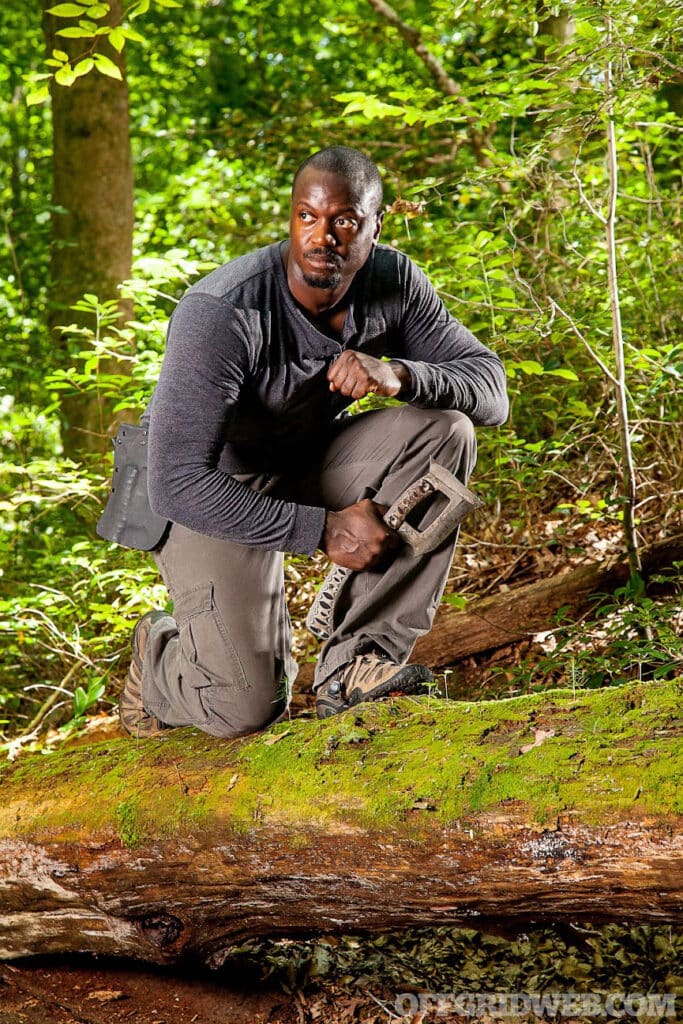
Above: Hakim designed this Tengu ax and brought it with him on Naked and Afraid. Its versatile design and multiple cutting surfaces helped with a variety of survival tasks.
What were your survival priorities going into the show? How did they change once you were out in the field?
That’s a beautiful question, because I had all the priorities, and I had it all figured out. I had practiced at home on my own in the wilderness. I was like, “OK, day one, I know I’m going to be hydrated and full, so all I have to worry about is making sure I find a spot to build a nice shelter. Day two, I’m going to find some water, because I know that’s going to be the next important thing on the list.
Day three, I’m going to build some shoes so I can move around quickly. Day four, I’m going to start looking for some sources of food while thinking about what I can use for some sort of clothing.” None of that happened.
On the first day, we had very little daylight left by the time we got to our destination. We had to pull together a shelter and a fire as soon as possible so we could make it through the night. And then it was just catch-up from there. Once we felt how cold it was that first night, we had to really reinforce our shelter. My partner was sick with a stomach virus from some water she drank, so we had to deal with that.
Then, we had to find drinkable water, because we were at high altitude and had been moving a lot, and that affected us more than we thought. And then like I said, trying to find firewood and keep ourselves warm was the major priority, especially once we realized there wasn’t a lot of food out there and it was so cold.
With every reality TV show, we always wonder if events are scripted or if producers intervene to make the show more exciting. Did you experience anything like that?
There wasn’t a lot of intervention. However, the producers do come out and ask you questions. Some of those questions can be a little guiding, as if they’re trying to see if there’s any tension. They’re trying to pull that out. So, there’s a little bit of that manipulation. But I didn’t personally feel like the producers were trying to create anything that wasn’t there.
That was my experience back then, but of course they’re on season 15 or 16 now. It’s a whole different world now, so I don’t know what it would be like today.
What was it like attempting to survive alongside a partner you had never met before?
That was one of the toughest things. You’ve got two people who’ve never met each other, who don’t know what each other’s personalities are, trying to survive this really chaotic situation. It was beyond challenging. We ended up pulling it together, but in those first few days, it was really difficult. She was sick, dealing with those issues. I was trying to deal with her being sick, and also deal with my own issues of trying to make a plan and get it done.
How did your time on the show end, and what survival lessons did you walk away with?
My times on the show ended well. Well, I had a hard time with the second one in Colombia, but the first one in the Himalayas I think I did good. But both changed my entire life. They taught me what was really important, and changed the trajectory of who I am. They also caused me to want to start this thing called the Soil Foundation, which is a nonprofit organization.
I own 100 acres of land in North Carolina, and I’ve been taking people out and giving them wilderness experiences. Ultimately, I want to do more experiential training out on the property. We are able to provide getaways for people to explore their deeper inner self, so that they can awaken to some of the things that they may have been hiding from themselves due to all the distractions we have in our society.
That was probably the greatest survival skill — recognizing who I am deep down. People need to know that if they’re going to survive any type of real hardship.
Please tell us about your latest projects and where we can follow you online.
I have two awesome projects. Like I said, I created the Soil Foundation. It is a wilderness therapy organization where we specialize in providing outdoor wilderness experiential retreats to help people find out things about themselves and come to terms with things, and hopefully heal from any past trauma in that process. We’re also trying to raise money for a conference center and event space made out of shipping containers.
If you’d like to assist with that or donate, you can go to our website, thesoilfoundation.org.
The next thing is Survive University, my online survival platform. It deals with everything from how to survive based on finances, how to survive based on emotion and psychology, and how to survive based on physicality — wilderness and bushcraft things as well as self-defense. That’s at surviveuniversity.com.
You can also find me at hakim-isler.com.
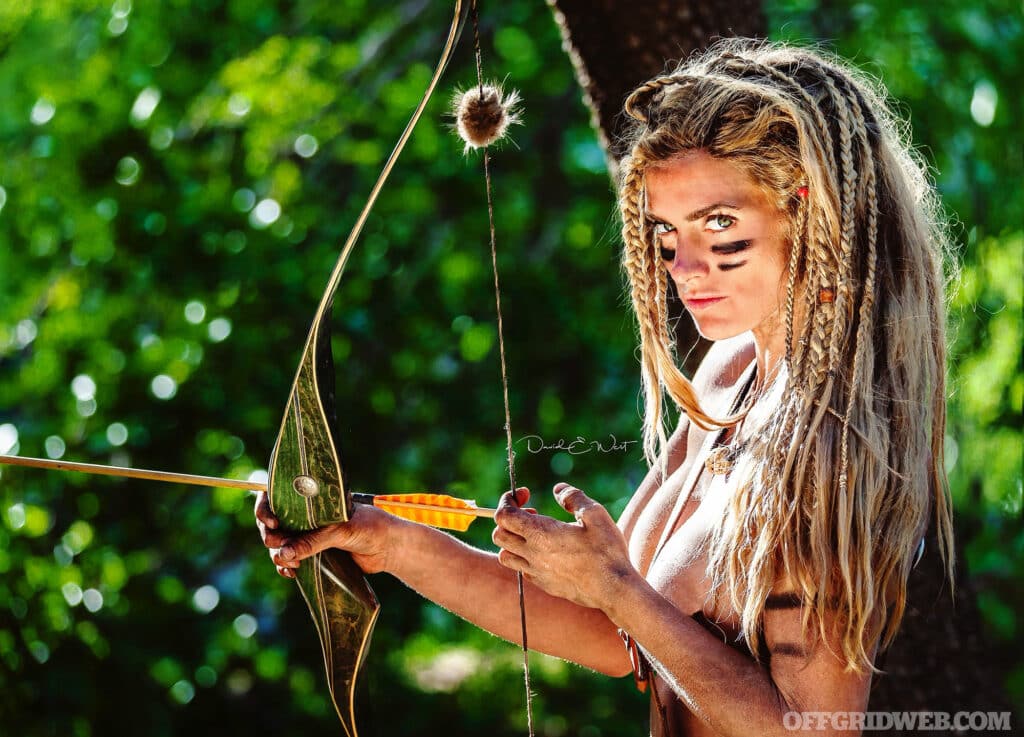
Above: Publicity photo prior to the 40-day challenge in Africa (Photo courtesy of David E. West).
Age: 34
Hometown: Fenton, MI
What season(s) did you participate in? Where did you go?
Season 7 (21 days): Ecuador, Amazon Rainforest; Season 4 Naked and Afraid XL (40 days): South Africa; and Season 10 (21 days): Florida Swamplands
Tell us a little about your survival skills background going into the show.
Growing up, I was always outdoors and that followed me into adulthood. A lot of my life was spent on a lake where I learned how to fish. After graduating college, I taught outdoor education and wilderness survival classes at a nature preserve for several years. I got really passionate about primitive survival, which coincided with me applying for the show.
We understand each contestant was allowed to bring one item. What did you bring, and why?
An inside fact about Naked and Afraid is that the producers actually asked us to bring four items to location. They ultimately chose which one went on the show with us. Production also provides one item depending on what items the survivalists are given.
In Ecuador, I had my hand-fishing line. The fish are abundant there, and it fed us well throughout the three weeks we were on location. I ate lots of red-bellied piranha.
In South Africa, I brought my bow. It was a vintage Bear Archery Kodiak Hunter. I went with the intention of hunting big game, but it ended up providing us food in a different way — catfish. I’d take daily walks to a watering hole with it and bow fish catfish there. On this challenge, we were also allowed a knife, and I brought my TOPS Knives B.O.B Fieldcraft knife.
In the Everglades, both items out there ended up being mine. I actually found out who my partner was going to be ahead of time, and I gave him my Nepalese Khukuri before we went on location. I brought my fire-starter.
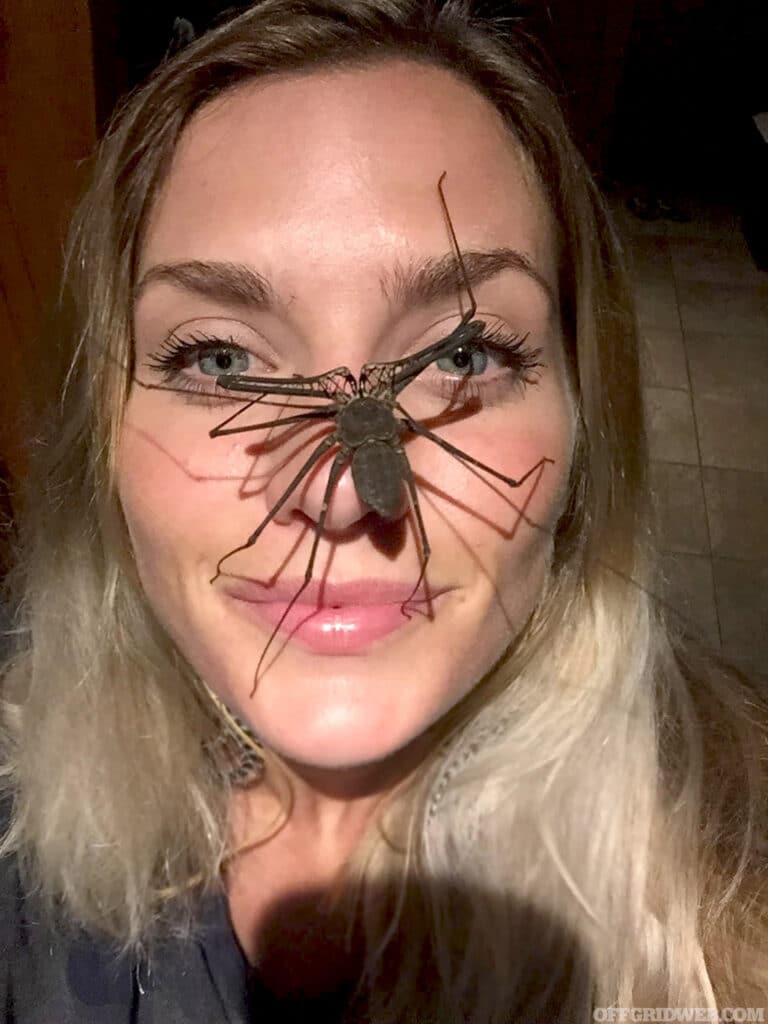
Above: Melissa playing with critters in the Amazon before her first challenge.
Exposure is a serious threat in any outdoor setting, and nudity is the ultimate form of exposure. What challenges did being naked pose?
Being naked is what separates this show from any other survival challenge. It’s indescribably miserable. Every inch of your body is at constant exposure to moisture, cold temperatures, and bugs. In environments like the Amazon rainforest, I was a food source for countless mosquitoes. Leafcutter ants are everywhere there and are quick to bite anything in their path.
In South Africa, every other step is a thorn in the foot. There were some very cold nights there in which having partners to share body heat with saved me.
In the Everglades, I was covered in poison ivy. The mosquitoes sucked there too (no pun intended).
It’s in the name, so we’ve got to ask. Were you afraid out there? Tell us about the psychological impact of the scenario you faced and how you dealt with it.
Psychologically, the most difficult things for me were the boredom and the rain. One day feels like a week out there — I really cannot emphasize how slowly time goes by. Without distractions, you very quickly realize what and who is important in your life.
My biggest fear out there was never the animals; it was the rain. Rain threatens your fire, your shelter’s integrity, and your core body temperature. A really rainy environment is, in my experience, the most difficult and miserable environment to survive in.
What were your survival priorities going into the show? How did they change once you were out in the field?
My priorities were to establish a good shelter, get a sustainable fire set up, and to not get sick or infected with parasites. Maintaining fire out there was a priority and an unexpected obsession, especially in the rainforest where it’s so hard to start a fire. Keeping a fire provided warmth, food, comfort, entertainment, water, and protection from insects and animals.
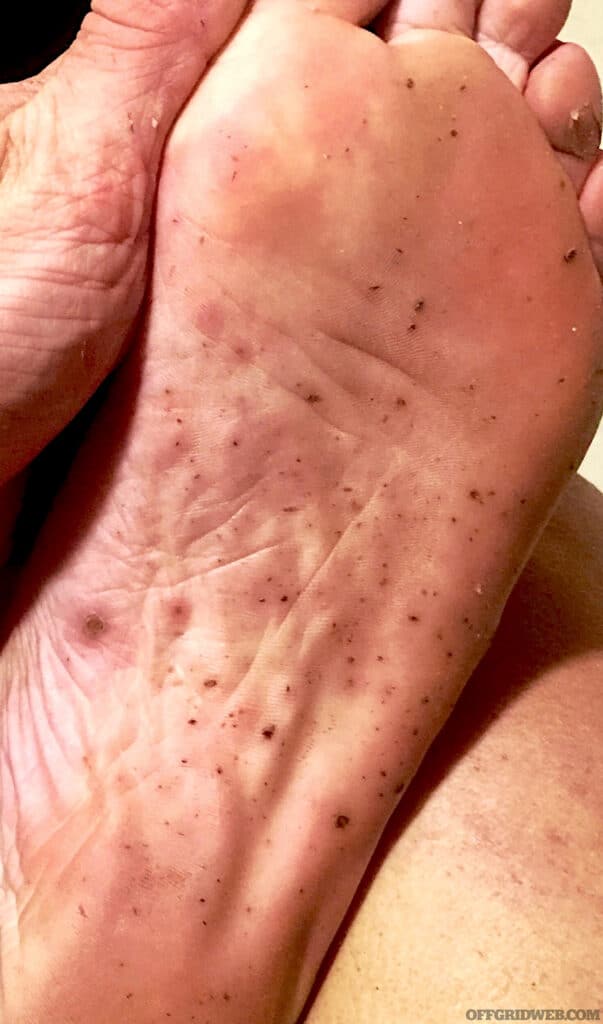
Above: “After Ecuador, hundreds of thorns were embedded in my feet. My hands were burnt, callused, and growing nail fungus.”
With every reality TV show, we always wonder if events are scripted or if producers intervene to make the show more exciting. Did you experience anything like that?
Interaction with production and crew is very limited. There were times where producers might ask us to go on a hunt or do something entertaining for that day. And of course, they might try to facilitate some sort of drama with their interview questions. When we did the 40-day challenge, the editing made it look like there was some sort of deep internal tribe conflict (there wasn’t).
At times I was disappointed to see so much of the editing went toward drama and conflict rather than survival. But I understand it’s TV, and drama/conflict is entertaining.
What was it like attempting to survive alongside a partner you had never met before?
You are placed in an extremely stressful survival situation and trying to work through it with a total stranger. The first day is really rough — you only have a few hours to (hopefully) establish shelter and fire before nightfall, and you need to make all of these really fast decisions and execute them as a cooperative team, or you’re screwed.
In my first challenge, it was really difficult at first because we had totally different approaches to survival. My partner’s background was in the military and mine was in primitive survival/bushcraft. By the end, we figured out how to work well together and became lifelong friends after the show. I stay in touch with all of my previous partners to this day.
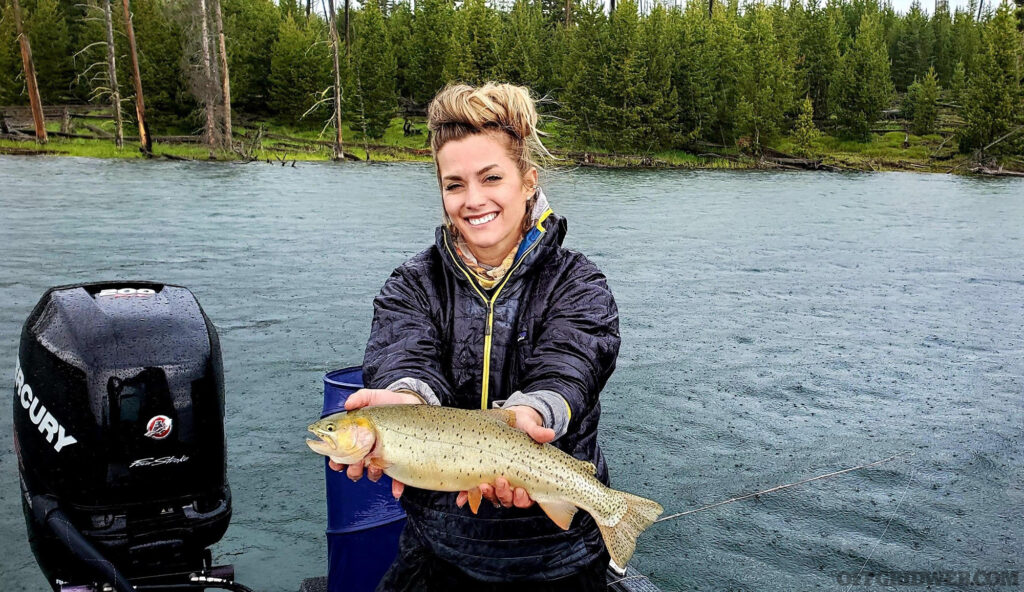
Above: “Growing up on a lake helped me learn about fishing from a young age. This knowledge provided a big part of my food supply during the survival challenges.”
How did your time on the show end, and what survival lessons did you walk away with?
I completed all my challenges successfully and learned a lot. A few things that really stick out:
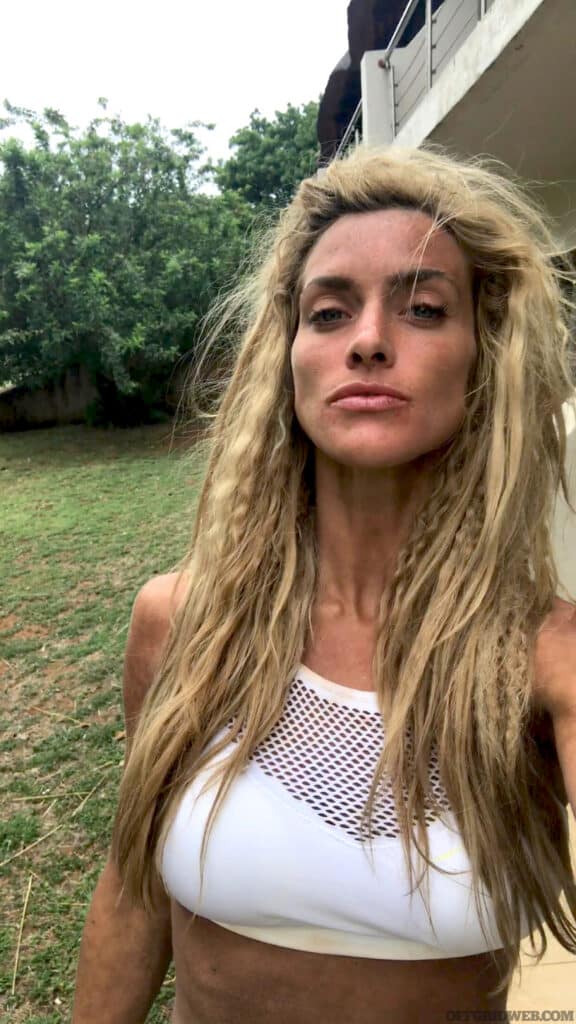
Above: Returning to the hotel after 40 days in Africa. “I felt like a wild animal.”
Please tell us about your latest projects and where we can follow you online.
I work for the World’s Largest Knife Show, BLADE Show alongside BLADE Magazine doing social media and digital marketing. I’m also on YouTube, Instagram, TikTok, and Facebook as @MelissaBackwoods where I’m actively reviewing knives and survival gear daily.
Subscribe to Recoil Offgrid's free newsletter for more content like this.
 STAY SAFE: Download a Free copy of the OFFGRID Outbreak Issue
STAY SAFE: Download a Free copy of the OFFGRID Outbreak Issue
No Comments